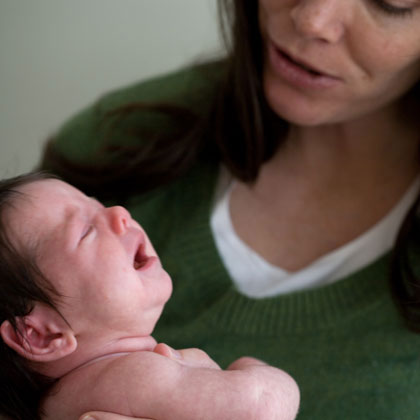Infant Colic
Infant colic is a problem occasionally seen in infants, usually between one and four to six months of age.
Most babies have a “fussy” time during the day, but an infant with colic will draw their legs up on their stomach and cry inconsolably for a short while as if they had a bad stomach ache.
The colicky crying tends to resolve over several minutes only to come again some time later, often the next day. Unfortunately, there is no one problem which causes colic that we know about. We know of several things which “sometimes” help in some babies; but, no definitive cause has been found. Sometimes crying is from a formula allergy or problems with other foods.
Sometimes it has to do with the nipple size or shape, which may allow the baby to suck a great deal of air with the formula.
And sometimes, in breast fed babies, it has something to do with the food that the mother is eating like spicy food, chocolate, or even milk.
By “sometimes” I mean that once in awhile when a pediatrician suggests correcting one of those rationales, the baby’s colic disappears. In other words, it worked on that particular infant but that doesn’t mean that it will on other infants or that it is a scientifically based “official” cause. We really don’t have that kind of evidence for any cause.
Colic is not, however, usually associated with vomiting, cough, or other symptom. It occurs only at certain periods of the day, not all day long and it does not produce a fever.
Many people jump to the conclusion that a fussy baby has colic, but that assumptioin is not always appropriate.
Any infant in whom there are other symptoms besides fussiness; or babies under one month or over four months; or who also have a fever, should be seen by their pediatrician prior to making a diagnosis.
 A new study has shown that colic may be linked to introducing solid foods before four months of age.
A new study has shown that colic may be linked to introducing solid foods before four months of age.
In a study of 843 infants on the Isle of Wight, England, colic affected 135 of them (16%).
They found that a vast majority of these children had developed colic by six weeks of age but had their remission by three months of age. Some had remission up to six months of age.
Colic was noted more often in infants introduced to mixed feeding (cereals or solids) before they were three months old. The prevalence of colic, however, did not significantly differ between totally breast fed babies and babies fed only formula.
I believe it is a dangerous practice to make assumptions that a crying baby has colic and that infants should be evaluated in the office by a pediatrician. It would be too bad to miss something correctable.
Once a diagnosis is made, there are some common things we try on infants who have colic.
- If the infant is on a cows milk formula, a trial of soy type formula (Isomil, Prosobee) is usually given. If the mother is breastfeeding and drinking a lot of milk herself, most physicians will request that she try going off of all milk in her diet for a week to see if that helps.
- Any solid foods which have already been introduced should be withdrawn for a period of time.
- Changing the style of infant bottle nipples sometimes helps. Most babies have their own sucking style and may respond to one nipple better than another. It is probably best to use the plastic bag type, collapsible bottle liners that tend to not allow the baby to get as much swallowed air with feedings.
- Burping is the main-stay of treatment. A child can be burped at any time. Before feeding, and after each ounce (or five minutes of breast feeding), and after the feeding. If the baby does not give a good burp he can be propped upright for a few hours after feeding and burped at a later time. A baby who has just finished crying has swallowed a lot of air and needs to be burped again. In short, burp the baby about every time you see them.
- Keeping the baby upright in an infant seat for two to three hours after feeding sometimes helps.
- Giving the baby a warm bath or a ride in the car until his daily fussy time is over sometimes helps.
- And, there are some sedative type medicines which your physician can prescribe to ease distress if really needed.
Many times the above measures help and sedation is not needed.
Advertisement by Google
(sorry, only few pages have ads)

